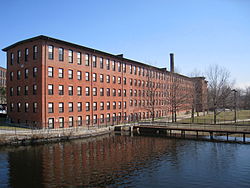Boston Manufacturing Company | |
 Boston Manufacturing Company, Waltham, Massachusetts | |
| Location | 144-190 Moody St., Waltham, Massachusetts |
|---|---|
| Coordinates | 42°22′23″N 71°14′9″W / 42.37306°N 71.23583°W |
| Built | 1813 |
| Architect | Paul Moody |
| NRHP reference No. | 77001412 |
| Significant dates | |
| Added to NRHP | December 22, 1977[1] |
| Designated NHLD | December 22, 1977[2] |
The Boston Manufacturing Company was a business that operated one of the first factories in America. It was organized in 1813 by Francis Cabot Lowell, a wealthy Boston merchant, in partnership with a group of investors later known as The Boston Associates, for the manufacture of cotton textiles. It built the first integrated spinning and weaving factory in the world at Waltham, Massachusetts, using water power. They used plans for a power loom that he smuggled out of England as well as trade secrets from the earlier horse-powered Beverly Cotton Manufactory, of Beverly, Massachusetts, of 1788.[3] This was the largest factory in the U.S., with a workforce of about 300. It was a very efficient, highly profitable mill that, with the aid of the Tariff of 1816, competed effectively with British textiles at a time when many smaller operations were being forced out of business.[4] While the Rhode Island System that followed was famously employed by Samuel Slater, the Boston Associates improved upon it with the "Waltham System". The idea was successfully copied at Lowell, Massachusetts, and elsewhere in New England. Many rural towns now had their own textile mills.
- ^ "National Register Information System". National Register of Historic Places. National Park Service. January 23, 2007.
- ^ Cite error: The named reference
nhlsumwas invoked but never defined (see the help page). - ^ Robert W Lovett, "The Beverly Cotton Manufactory: Or some new light on an early cotton mill Bulletin of the Business Historical Society pre ( Dec 1952) 26, 000004; ABI/INFORM(pg. 218)
- ^ Kenton Beerman, "The Beginning of a Revolution: Waltham and the Boston Manufacturing Company." The Concord Review (1994) online Archived 2015-04-02 at the Wayback Machine.

